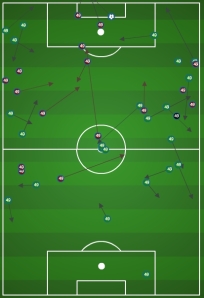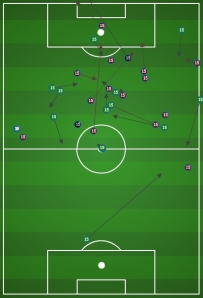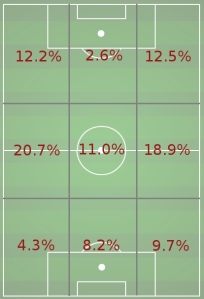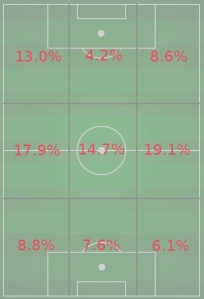So you’re excited about the US Men’s National team breaking through the group stage? It may even be that you find yourself liking this whole soccer thing. That’s not surprising; most Americans you talk to that follow soccer, including myself, have had that specific moment that sealed commitment, a moment often from a past World Cup. Whether that be the 2002 World Cup run in South Korea or the 2010 heart break against Ghana that brought you to the “beautiful game," because of the placement that soccer has in the standings of American culture, it’s just common to have these iconic moments associated with the sport. The thing that distinguishes people like us from the rest of the excited US supporters across the nation during this time is that, once the World Cup tournament concludes, we'll still want more.
Well, fear not because there is a serious and thriving league here in the US. If you are or have ever been called a ‘Euro snob’, then you can probably stop reading now. You’re going to argue and just generally disagree with most everything I have to say. So what’s the point? I’m not trolling you and it’s great that you like soccer in Europe. But we’re to talk to these new recruits about soccer in the United States. So here we go. Here are five reasons and examples about soccer in the US, and why you should follow it after the World Cup.
1) Soccer in the United States is actually good.
Once upon a time Major League Soccer was viewed as a retirement league. A place where aged stars came for one last pay day once they were out of their prime. It was viewed as such simply because it was exactly that. It wasn’t that long ago, and because of that there some pretty common misconceptions about MLS.
“It used to be that just CONCACAF [The Confederation of North, Central American and Caribbean Association Football] internationals and retirees came here. In 2014 Brazilians, Spaniards, Englishmen (that just miss out), Australians, Persians (Iran), and Irish all play in MLS, and they also play roles for their home countries in the World Cup, or are of World Cup quality.”
Look, most people that don’t like MLS likely have not watched more than a couple of games; which is silly considering they base all their opinions on those few games. It would be like me basing the entirety of the NBA on a Cleveland and New Orleans games or New Jersey and Phoenix. Neither of which are what we would call riveting match-ups.
The quality of MLS is improving every year. If you believe MLS still to be a ‘retirement league’ or a ‘first division with watered down depth’ you haven’t really invested any time in getting your facts straight. Truth is most people are forming opinions based on a small sample size from years ago.
Looking at numbers produced by Dave Clark and the statistician known by the handle Sidereal, one finds strong indicators that MLS has just continued to improved over the last few years. The league is gaining traction to being near par with some quality European soccer leagues.
2) MLS is on the verge of getting even better and it starts with increased wages.
“Although not often addressed, there's no question that achieving that vision will require increasing MLS player salaries to attract more top players. It's just a question of how fast, and the salaries may need to increase much sooner than 2022.”
“…”
“What could the future MLS look like? Or what would it need to look like for the Don Garber to see his vision meet reality? Let's build the reality. Let's assume by 2022 the MLS will pay their players 50% of total revenues, in line with the current Bundesliga level. MLS won't need to reach revenues of the Bundesliga to be considered a top league in the world, but they will need to be close to be paying quality players closer to market rate. Let's assume that MLS can achieve Don's dream by reaching Ligue 1 revenues but paying Bundesliga salaries. Finally, let's assume that Ligue 1 revenues grow at a modest 4% per year until 2022.”
“…”
“The target MLS revenue growth of 16% is very aggressive but Don Garber has a good amount of low hanging fruit to pick. The new rumored TV deal is for about $100M in 2015 and would increase the 2012 revenues (the basis for these numbers) by nearly 15%. The next TV deal might fetch the same 15% growth or more. MLS has also announced a five-team expansion plan which will bring at least 26% growth as the teams come on. Without doing much, MLS can get almost a third of the way to the goal according to my calculations.”
Okay, I pray that Jared will forgive me for lifting so many of his brilliant words from his article. Go read the whole piece because it’s great. Unfortunately it’s a bit of an involved article, and I just wanted to frame a great thought from his head.
The United States first division is growing, and growing at a substantial rate. That is due to the injection of money and the fact they can start paying players what their worth. This brings in more players from all over the place that can use the league as not just a place to end their career, but really to start it.
A new Collective Bargaining Agreement will be negotiated this year after the season is over. I get that most of us sports fan are sick of labor talks and news of player strikes. I read you loud and clear. The thing that makes this different is simply that the league gets better with increase salary caps for clubs and the increase of minimum player wages. I don’t want there to be a work stoppage, but with the increased revenue from the TV deal that MLS just signed, they owe it to the players and fans to further the cause of soccer in this country.
3a) It’s not just about overpaying old guys to get eyeballs, MLS is acquiring young and exciting talent…
The main example you could probably point to for young guys coming into the league is Fredy Montero. Montero has transitioned over the last 18 months from one of the MLS top scorers to being a perennial talent in Portugal. Montero, who spent four very good seasons in Seattle, had the opportunity to make mistakes in a league that pushed his abilities enough even four years ago.
Montero’s arrival was followed by an influx of young international talent.
Darlington Nagbe, for example, is an international and former collegiate star at the University of Akron. He has been a critical piece for the Portland Timbers, is one of the most creative and eccentric talents in all of MLS.
Fabian Castillo, the Columbian winger with plenty of technical prowess, passed up opportunities in Europe for a stable playing environment and a chance for consistent playing time in Dallas.
Deshorn Brown is a high-end prototypical speedster from Jamaica. In his first season with the Colorado Rapids, he lead his club in goals scored and took them to the playoffs for the first time in four seasons.
For every Montero, however, there will always be a player that just doesn’t work out. The examples are many. In spite of that, MLS has begun the reverse transition from retirement league to what many would call a feeder league. While many, if not most, would not purpose to spend the prime of their careers in MLS (see point: 3b), they can still make a fine career for themselves and good wages because of how the league has grown to reward these players.
More and more young players are coming here in the vein of Montero, now viewing the US as an opportunity to get on the radar of European scouts and develop a pathway to launch a more lucrative career while still having stability and having the chance to prove them in a physical league.
“The increased visibility in M.L.S. is attractive to the players, who also benefit from the league’s financial stability compared with some leagues in their home countries.” (Leander Schaerlaeckens, NY Times)
It’s true that MLS still has more players retire at the end of the year from soccer than will transfer out of its league, but the players that are being transferred out are going to better and better clubs.
3b) ...and some of that league talent is even in its prime.
As I said, there aren’t many who look at MLS and think “gosh, I could have a good living in the US in the prime of my career." However there are a few where the stars lined up perfectly and they've chosen to play in America rather than going abroad with their talents. Such examples are:
Diego Valeri, the creative midfielder from Argentina, has been a force since arriving in Portland. And teamed with their young budding star, Nagbe, they're a spectacular pair just to watch.
Juninho, the Brazilian, is often glossed over in terms of the whole league, but his consistency in LA and his ability to play both ways centrally is fantastic. He could be earning much more abroad but the allure of being on an iconic franchise and coached by one of the best US coaches in the business, Bruce Arena, keeps him in LA... for now.
Osvaldo Alonso is a unique case. His heroic escape from Cuba and passport situation limit his options abroad, but believe me... he has them. Yet, he loves Seattle and MLS. He's easily a top-3 midfielder in the entire league and still has a couple prime seasons left in the tank.
Matt Besler, the Sporting KC and USMNT centerback has had chances to go abroad, and yet here he is in his prime. This has happened by way of MLS introducing retention funds to pay for... well, people whom they define as worthy of using it. His salary relative to the cap has been kept manageable because of those funds and he loves playing in Kansas City. He's possibly and probably the best defender in MLS.
4) It’s not just about foreign talent; we have a thriving league to grow future US national team talent.
Players like Shane O’Neil (Colorado), Luis Gil (Real Salt Lake), Benji Joya (Chicago) and DeAndre Yedlin (Seattle) are just a few names that play significant roles on their MLS clubs, and they still can't drink legally in this country. You could almost have thrown Will Trapp (Columbus) on this list too, but he busted the beer-drinking landmark at the beginning of the year.
All four have been featured in U-23 matches gearing up for the Olympics, just two short years away, and all look to be prominent members of future World Cup teams. There are others worth mentioning also, but the point here is that MLS is starting to become a facilitator of growing US talent. That’s important.
That doesn’t even highlight players such as Gyasi Zardes or Jack McInerney, who are both big-time names in the league and may not qualify as members of the Olympic roster. It also doesn’t include 19-year old striking sensation Diego Fagundez, who just graduated from high school two weeks ago and just entered his fourth season as a member of the New England Revolution. Sadly enough, he is still technically not a US citizen…yet.
5) There is parity, and possibly more so here than in any other relevant league in the world.
“The three factors above were weighted equally and assigned a standard deviation (either + or -) for each league and each metric. Add them up and MLS is indeed the most competitive league in this 15-league sample. Interestingly, Brazil was not far behind. Of course, there are multiple ways one can measure parity and competitiveness, and this is just one of many approaches.” - Alex Olshansky
“This consistency, when combined with MLS’s overall lower variation, results in a lower proportion of the MLS’s points variation resulting from actual talent differences. The overall impact is that MLS table results are nearly a 50/50 split between talent and luck.” - Zach Slaton
Everyone hates the Yankees and yet wants to be them. It’s one of the greatest catch-22’s in sports. We all hate the winner---unless, of course, it’s us. MLS has developed a single entity program that just doesn’t lend itself to helping clubs that win, but it helps those that do not. In fact it’s worse to finish middle of the pack in the league than to finish at the back.
The league subsidies the salary cap of certain teams based on the order in which the teams finished. Teams towards the bottom get certain stipend (called allocation money) that assists in pay down contracts for cap purposes. Teams at the top also are awarded this money as a means of deepening the team for international competition in CONCACAF Champions League. This enables them to compete against the Mexican League teams that often tend to be superior in talent depth.
This all creates an environment on a yearly basis that creates volatility in casting predictions and makes the whole process rather difficult. A team can be good and have bad luck (see: LA Galaxy) or it can be mediocre with good luck (see: Real Salt Lake, according to Matthias), or it can have best of both worlds (see: Seattle Sounders). The beauty is that teams are never that far out of it, and never that far ahead.
The team that serve as the best example of this anything-can-happen league is DC United. Our readers had predicted prior to the season that they would miss the play-offs and would be generally sit near the bottom. In fact 15% thought they would end up dead last, opposed to the less than 1% that thought they would win the conference. Currently sitting nearly halfway through the season, they are in good position to fight for that very chance. And last year, this is the same club that nearly set all types of records for being anemic and generally pathetic in their overall performance.
There are few, if any, instances in which you can point to a club going from worst to best in a single season. The 1990 Atlanta Braves come to mind for me, but thinking abroad in the world of soccer, that seems improbable if not all together impossible. In MLS, it's a yearly event.
-------
These are just a few reasons on why you should turn your attention to Major League Soccer after the World Cup. I'm sure others could add to this list, and generally speaking I know I missed things that others would include. But in talking with so many people down here in the South, I felt compelled to at least try to provide a this motivation to get involved in a dynamic league right here in the United States.







